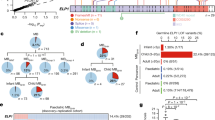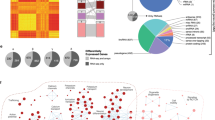Abstract
The sonic hedgehog (SHH) signaling pathway directs the embryonic development of diverse organisms and is disrupted in a variety of malignancies. Pathway activation is triggered by binding of hedgehog proteins to the multipass Patched-1 (PTCH) receptor, which in the absence of hedgehog suppresses the activity of the seven-pass membrane protein Smoothened (SMOH). De-repression of SMOH culminates in the activation of one or more of the GLI transcription factors that regulate the transcription of downstream targets. Individuals with germline mutations of the SHH receptor gene PTCH are at high risk of developmental anomalies and of basal-cell carcinomas, medulloblastomas and other cancers (a pattern consistent with nevoid basal-cell carcinoma syndrome, NBCCS). In keeping with the role of PTCH as a tumor-suppressor gene, somatic mutations of this gene occur in sporadic basal-cell carcinomas and medulloblastomas. We report here that a subset of children with medulloblastoma carry germline and somatic mutations in SUFU (encoding the human suppressor of fused) of the SHH pathway, accompanied by loss of heterozygosity of the wildtype allele. Several of these mutations encode truncated proteins that are unable to export the GLI transcription factor from nucleus to cytoplasm, resulting in the activation of SHH signaling. SUFU is a newly identified tumor-suppressor gene that predisposes individuals to medulloblastoma by modulating the SHH signaling pathway through a newly identified mechanism.
This is a preview of subscription content, access via your institution
Access options
Subscribe to this journal
Receive 12 print issues and online access
$209.00 per year
only $17.42 per issue
Buy this article
- Purchase on Springer Link
- Instant access to full article PDF
Prices may be subject to local taxes which are calculated during checkout



Similar content being viewed by others
References
Dahmane, N. & Ruiz-i-Altaba, A. Sonic hedgehog regulates the growth and patterning of the cerebellum. Development 126, 3089–3100 (1999).
Wechsler-Reya, R.J. & Scott, M.P. Control of neuronal precursor proliferation in the cerebellum by Sonic Hedgehog. Neuron 22, 103–114 (1999).
Hahn, H. et al. Mutations of the human homolog of Drosophila patched in the nevoid basal cell carcinoma syndrome. Cell 85, 841–851 (1996).
Johnson, R.L. et al. Human homolog of patched, a candidate gene for the basal cell nevus syndrome. Science 272, 1668–1671 (1996).
Gorlin, R.J. Nevoid basal-cell carcinoma syndrome. Medicine (Baltimore) 66, 98–113 (1987).
Kimonis, V.E. et al. Clinical manifestations in 105 persons with nevoid basal cell carcinoma syndrome. Am. J. Med. Genet. 69, 299–308 (1997).
Raffel, C. et al. Sporadic medulloblastomas contain PTCH mutations. Cancer Res. 57, 842–845 (1997).
Unden, A.B. et al. Mutations in the human homologue of Drosophila patched (PTCH) in basal cell carcinomas and the Gorlin syndrome: different in vivo mechanisms of PTCH inactivation. Cancer Res. 56, 4562–4565 (1996).
Wolter, M., Reifenberger, J., Sommer, C., Ruzicka, T. & Reifenberger, G. Mutations in the human homologue of the Drosophila segment polarity gene patched (PTCH) in sporadic basal cell carcinomas of the skin and primitive neuroectodermal tumors of the central nervous system. Cancer Res. 57, 2581–2585 (1997).
Zurawel, R.H. et al. Analysis of PTCH/SMO/SHH pathway genes in medulloblastoma. Genes Chromosom. Cancer 27, 44–51 (2000).
Taylor, M.D., Mainprize, T.G. & Rutka, J.T. Molecular insight into medulloblastoma and central nervous system primitive neuroectodermal tumor biology from hereditary syndromes: a review. Neurosurgery 47, 888–901 (2000).
Reifenberger, J. et al. Missense mutations in SMOH in sporadic basal cell carcinomas of the skin and primitive neuroectodermal tumors of the central nervous system. Cancer Res. 58, 1798–1803 (1998).
Xie, J. et al. Activating Smoothened mutations in sporadic basal-cell carcinoma. Nature 391, 90–92 (1998).
Kinzler, K.W. et al. Identification of an amplified, highly expressed gene in a human glioma. Science 236, 70–73 (1987).
Goodrich, L.V., Milenkovic, L., Higgins, K.M. & Scott, M.P. Altered neural cell fates and medulloblastoma in mouse patched mutants. Science 277, 1109–1113 (1997).
Hahn, H. et al. Rhabdomyosarcomas and radiation hypersensitivity in a mouse model of Gorlin syndrome. Nature Med. 4, 619–622 (1998).
Nilsson, M. et al. Induction of basal cell carcinomas and trichoepitheliomas in mice overexpressing GLI-1. Proc. Natl Acad. Sci. USA 97, 3438–3443 (2000).
Grachtchouk, M. et al. Basal cell carcinomas in mice overexpressing Gli2 in skin. Nature Genet. 24, 216–217 (2000).
Oro, A.E. et al. Basal cell carcinomas in mice overexpressing sonic hedgehog. Science 276, 817–821 (1997).
Bayani, J. et al. Molecular cytogenetic analysis of medulloblastomas and supratentorial primitive neuroectodermal tumors by using conventional banding, comparative genomic hybridization, and spectral karyotyping. J. Neurosurg. 93, 437–448 (2000).
Zurawel, R.H., Chiappa, S.A., Allen, C. & Raffel, C. Sporadic medulloblastomas contain oncogenic β-catenin mutations. Cancer Res. 58, 896–899 (1998).
Pomeroy, S.L. et al. Prediction of central nervous system embryonal tumour outcome based on gene expression. Nature 415, 436–442 (2002).
Lobo, S., Cervenka, J., London, A. & Pierpont, M.E. Interstitial deletion of 10q: clinical features and literature review. Am. J. Med. Genet. 43, 701–703 (1992).
Ohlmeyer, J.T. & Kalderon, D. Hedgehog stimulates maturation of Cubitus interruptus into a labile transcriptional activator. Nature 396, 749–753 (1998).
Sasaki, H., Hui, C., Nakafuku, M. & Kondoh, H. A binding site for Gli proteins is essential for HNF-3β floor plate enhancer activity in transgenics and can respond to Shh in vitro. Development 124, 1313–1322 (1997).
Meng, X. et al. Suppressor of fused negatively regulates β-catenin signaling. J. Biol. Chem. 276, 40113–40119 (2001).
Chidambaram, A. et al. Mutations in the human homologue of the Drosophila patched gene in Caucasian and African-American nevoid basal cell carcinoma syndrome patients. Cancer Res. 56, 4599–4601 (1996).
Wicking, C. et al. Most germ-line mutations in the nevoid basal cell carcinoma syndrome lead to a premature termination of the PATCHED protein, and no genotype–phenotype correlations are evident. Am. J. Hum. Genet. 60, 21–26 (1997).
Liu, L. et al. Mutation of the CDKN2A 5′ UTR creates an aberrant initiation codon and predisposes to melanoma. Nature Genet. 21, 128–132 (1999).
Raffel, C. et al. Analysis of oncogene and tumor suppressor gene alterations in pediatric malignant astrocytomas reveals reduced survival for patients with PTEN mutations. Clin. Cancer Res. 5, 4085–4090 (1999).
Ding, Q. et al. Mouse suppressor of fused is a negative regulator of sonic hedgehog signaling and alters the subcellular distribution of Gli1. Curr. Biol. 9, 1119–1122 (1999).
Acknowledgements
We thank the individuals and families who agreed to take part in these studies, and members of the McGlade laboratory for helpful discussions. This work was supported by the National Cancer Institute of Canada (NCIC) and the Michael Young Melanoma Fund (D.H.), a Terry Fox New Frontiers Award from the NCIC (C.C.H. and J.T.R.), the Canadian Institutes of Health Research (J.T.R. and C.C.H.) and Brainchild (J.T.R.). M.D.T. and T.G.M. were supported by Terry Fox fellowships from the NCIC with funds from the Terry Fox run. M.D.T. was subsequently supported by a fellowship from the Neurosurgery Research and Education Foundation.
Author information
Authors and Affiliations
Corresponding authors
Ethics declarations
Competing interests
The authors declare no competing financial interests.
Rights and permissions
About this article
Cite this article
Taylor, M., Liu, L., Raffel, C. et al. Mutations in SUFU predispose to medulloblastoma. Nat Genet 31, 306–310 (2002). https://doi.org/10.1038/ng916
Received:
Accepted:
Published:
Issue Date:
DOI: https://doi.org/10.1038/ng916
This article is cited by
-
Hedgehog ligand and receptor cooperatively regulate EGFR stability and activity in non-small cell lung cancer
Cellular Oncology (2024)
-
PRC2 disruption in cerebellar progenitors produces cerebellar hypoplasia and aberrant myoid differentiation without blocking medulloblastoma growth
Acta Neuropathologica Communications (2023)
-
Inhibition of the transcription factor ZNF281 by SUFU to suppress tumor cell migration
Cell Death & Differentiation (2023)
-
The role of Hedgehog and Notch signaling pathway in cancer
Molecular Biomedicine (2022)
-
ABT-737 suppresses aberrant Hedgehog pathway and overcomes resistance to smoothened antagonists by blocking Gli
Medical Oncology (2022)



